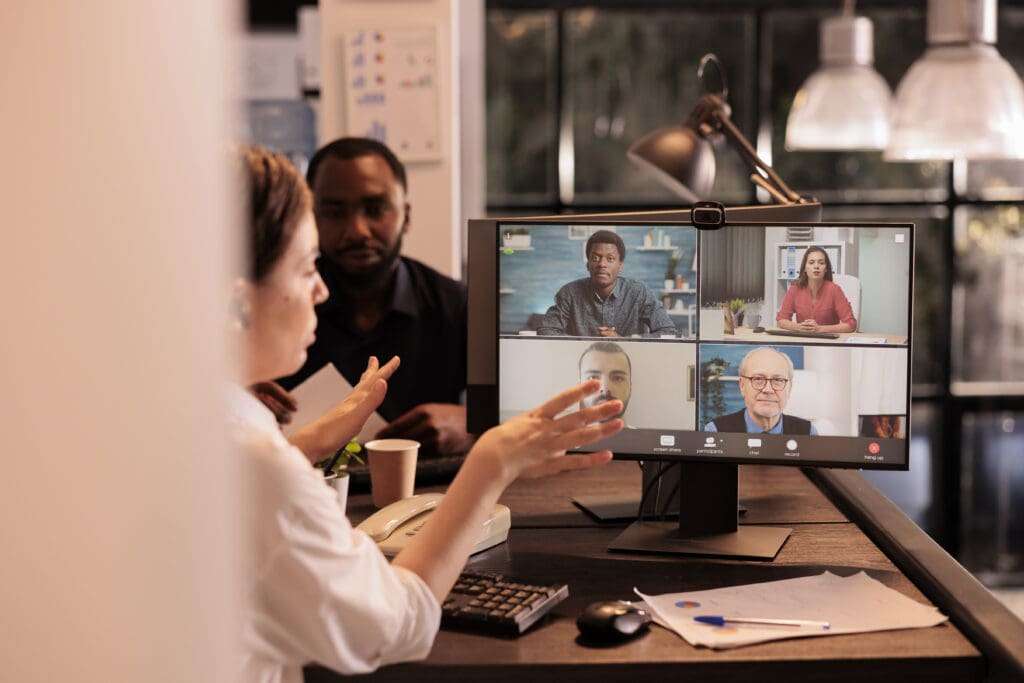Zoom just made a big move. It’s not just another feature rollout or a product tweak — it’s a full rebrand. From here on out, they’re Zoom Communications. Why? To show the world they’re not just a video meeting tool anymore — they’re a key player in the future of hybrid work, powered by AI.
For companies like Kadence, this is exciting. We share that same vision. Hybrid work, enhanced by AI, isn’t just the future — it’s what’s happening right now.
This isn’t just a marketing refresh for Zoom — it’s a reflection of the growing need for better collaboration in today’s hybrid, fast-paced work environments. While Zoom excels as a video collaboration app, Kadence is purpose-built to tackle the broader operational challenges of hybrid work. Together, our platform complements Zoom, creating a comprehensive solution that empowers teams to work smarter, wherever they are.
Why Zoom Matters for the Future of Work
Let’s rewind a little. Back in 2020, Zoom became a lifeline for millions of people suddenly working from home. (Did you know Zoom went from 10 million daily meeting participants in December 2019 to over 300 million in April 2020?) But times have changed, and so has Zoom. The rebrand to Zoom Communications is a statement: they’re not just about video calls anymore. They’re responding to need for hybrid work.
Now, they’re focused on delivering a suite of AI-powered tools to make hybrid video communication seamless. This evolution signals something bigger that Zoom have realized. Hybrid work isn’t just about where we work. It’s about how we work. And companies like Kadence and now Zoom are building the tools to help businesses thrive in this new reality.
The Team Behind the Vision
Zoom’s evolution into an AI-driven hybrid work platform is powered by a leadership team that understands innovation and the challenges of modern work.
At the forefront is CEO Eric Yuan, the visionary who founded Zoom. Yuan has long championed the transformative power of hybrid work, saying:
“Hybrid work is about flexibility and empowerment, and our goal is to build tools that make this not just possible, but seamless.”
Zoom’s Chief People Officer, Matthew Saxon, is also instrumental in shaping their hybrid work strategies. Saxon has been a strong advocate for flexible internal policies, ensuring Zoom practices what it preaches. Reflecting on hybrid work at Zoom, Saxon explains:
“Having the right technology that supports both is vital in fostering relationships in a hybrid environment.”
Zoom Puts AI at the Center of Work Transformation
Hybrid work isn’t just about connecting over video — it’s about making sure every aspect of flexible working is practical and seamless. That’s why Kadence offers a complete hybrid work solution, designed to tackle the logistical challenges of managing teams across multiple locations.
Here’s how Kadence supports hybrid work:
- Desk Booking and Room Management: Ensure employees have the spaces they need when they’re in the office, with intuitive tools to reserve desks, meeting rooms, and other shared resources.
- Team Scheduling: Make it easy for teams to plan their in-office days, fostering collaboration when it’s needed most.
- Analytics and Insights: Gain valuable data on space usage, team attendance, and hybrid work patterns, helping businesses optimize their office spaces and strategies.
- AI-Driven Coordination: Kadence simplifies hybrid logistics, from suggesting the best in-office days for teams to ensuring the right resources are available—all powered by AI.
Kadence provides businesses with the communication tools they need to streamline operations and maximize the value of video calls, making it an essential part of any flexible work strategy.
Zoom’s new AI features are a great complement to tools like Kadence, helping teams enhance communication and collaboration. With meeting summaries, actionable insights, and smarter collaboration features, Zoom makes video meetings more efficient and ensures everyone stays aligned.
Together, tools like Kadence and Zoom form a powerful hybrid ecosystem. Kadence takes care of the planning, scheduling, and logistics, while Zoom enables clear and effective video communication—ensuring your hybrid teams can work smarter, not harder.
What the Zoom Rebrand Means for Hybrid Work
At Kadence, we have been helping customers make hybrid work for them for the long term. We know that hybrid work isn’t just a trend — it’s how modern businesses operate. The challenge? Making it effective. It’s not enough to have people working from anywhere; they need to be able to collaborate, communicate, and feel connected.
Zoom Communications recognizes this. They’re no longer just enabling remote work—they’re seeing how hybrid offers better success than remote work and what hybrid work can look like when it’s done right. Their rebrand reflects a deeper understanding of what businesses need to succeed: tools that adapt to people, not the other way around.

How the Zoom Rebrand Impacts Businesses
For organizations everywhere, this rebrand is a signal: the way we work is changing – and companies like Zoom are catching up to the emphasis on hybrid and AI. Companies that invest in AI-driven tools now will be the ones leading the charge. The days of clunky workflows and endless meeting fatigue are over.
Zoom’s pivot also highlights something every business should consider: hybrid work isn’t just about flexibility — it’s about creating an environment where everyone can do their best work, no matter where they are.
According to a 2023 McKinsey report, organizations that effectively adopt hybrid work models see increases in productivity, employee satisfaction, and even retention rates. The key is having the right tools — and Zoom is betting big on being one of them.
Building the Future of Hybrid Work Together
At Kadence, we have championed this ethos since our inception. We believe hybrid work isn’t just a box to check — it’s a strategy that can unlock incredible potential.
While Zoom focuses on video communication, Kadence tackles the scheduling and logistics. Our AI-driven scheduling and space management tools make hybrid work practical. Need to coordinate who’s in the office? Done. Want to make sure your meeting spaces are optimized? Easy.
Together, tools like Kadence and Zoom create a powerful hybrid ecosystem — one that’s built to support teams, foster creativity, and drive results.
The Bottom Line
Zoom’s rebrand isn’t just a new logo or a snazzy name change — It’s a shift toward the future. Hybrid work, powered by AI, is no longer optional for businesses that want to stay competitive.
But here’s the thing: no single tool will solve it all. It’s about creating a stack of solutions that work together to make hybrid work, well, work. That’s where platforms like Zoom and Kadence come in.
So, as we head into 2024, ask yourself: Is your business ready for the next phase of work? Because the future’s already here — and it’s hybrid, AI-driven, and full of opportunity.





